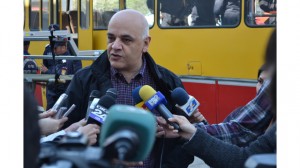The mass casualty transport equipment donated in Romania will be used to train emergency medical personnel from throughout the European Union.

First Line Technology recently donated an AmbuBus Bus Stretcher Conversion Kit to Romania’s EMS system and facilitated training on mass casualty transport.
“It was quite an experience being over there,” says First Line Technology Vice President Randy Sakowitz, who facilitated the training with Romanian emergency medical personnel.
The country’s EMS system is operated by the SMURD (Mobile Emergency Service for Resuscitation and Extrication) Foundation. Sakowitz first learned about SMURD from Romanian Minster of Health Dr. Raed Arafat at a NATO briefing last year. Dr. Arafat built SMURD from the ground up and will maximize the potential of the new AmbuBus Kit, Sakowitz says.
The kit is used to quickly equip regular buses to transport non-ambulatory patients from a mass casualty incident on stretchers or in wheelchairs. It can also be used free-standing for surge and sheltering operations, or permanently installed in a vehicle for immediate response. It has the capability of transporting up to 18 victims at one time, plus medical equipment and personnel.
“We were discussing mass casualty response and they didn’t have anything for large-scale disasters,” Sakowitz says. “When I was discussing the AmbuBus and how easy it is, they were very intrigued by it.”
The kit is also a good fit for the Romanian EMS system because it is compatible with the European equipment they already have.
“It’s all about reducing the amount of time it takes to provide critical care,” Sakowitz says.
The SMURD Foundation chose to locate the kit at their Targu Mures training center, one of the only mass casualty training centers in this region of the world. They plan to use the AmbuBus to train emergency medical personnel from throughout the European Union, and First Line hopes the collaboration will make a concrete contribution to regional emergency response.
Sakowitz was there for two days of training that included how to load and unload patients and how to triage efficiently. He worked with personnel including doctors, nurses and paramedics, as well as several shifts of responders at the fire department/training facility.
He explains that Romania is divided into regions, and that he trained the regional trainer.
“I was able to find out how they would use it (the kit) and train them. They were able to convert a bus in about 15 minutes,” Sakowitz says. “They just kind of picked up everything and did it.”
Sakowitz notes the training went both ways.
“At the same time I was learning from them because they have a lot of experience in this,” he says.
Romanian infrastructure originating from the 1400s is still in use; for example, a Transylvania castle continues to be used as a major event venue, Sakowitz says.
The biggest concern is the potential for earthquakes to cause buildings to come down.
In addition, cities and towns are separated by empty countryside, so for any train or vehicle incidents in between, “it’s essentially a wildland response,” Sakowitz says.
He hopes to go back at some point to continue to share lessons-learned with Romanian emergency response officials, based on their ongoing experience with it, and what First Line continues to learn from other users of the kit.
“We are all looking forward to seeing how the AmbuBus is used both for training at Targu Mures and for daily use and service within the local community.”
This article first appeared at EMSWorld.com on April 24, 2014.
